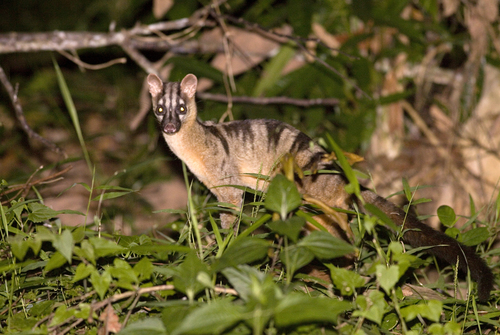
Banded Palm Civet
With its distinctive banded coat and elusive nocturnal habits, the Banded Palm Civet thrives in Southeast Asian rainforests. This arboreal mammal gracefully navigates the canopy, contributing to its ecosystem by dispersing seeds and controlling insect populations, embodying the delicate balance of its lush habitat.
15-20 years
Lifespan
1.4 - 4.5 kg
Weight
Height: 43 - 71 cm
Size
Brown, Grey, Yellow, Black, White, Tan
Color
Near Threatened
Conservation Status
Decreasing
Population Trend
Characteristics
The Banded Palm Civet (Hemigalus derbyanus) is a small, elusive carnivorous mammal native to the rainforests of Southeast Asia. It features a striking pattern of dark bands across its body, aiding in camouflage. Nocturnal by nature, it primarily feeds on small mammals, insects, and fruits, playing a crucial role in seed dispersal.
Distribution Range of the Banded Palm Civet
Hemigalus derbyanus, commonly known as the banded palm civet, is native to Southeast Asia. Its geographical distribution includes parts of the Malay Peninsula, Borneo, Sumatra, and some smaller surrounding islands. The species is predominantly found in countries like Malaysia, Indonesia, and Thailand.
Banded Palm Civet's Habitat
Environmental Conditions
The banded palm civet typically inhabits tropical rainforests that are characterized by high humidity and temperature. These forests are usually dense with vegetation, providing ample cover and resources for the civet. The species is also found in secondary forests and sometimes near plantations, adapting to areas with sufficient canopy cover.
Ecological Niche
Hemigalus derbyanus is primarily nocturnal and arboreal, spending much of its time in the trees. It plays a role in the ecosystem as both a predator and a seed disperser. The diet of the banded palm civet consists of small animals, insects, and fruit, indicating its role in controlling insect populations and facilitating forest regeneration through seed dispersal.
Copyright @ Nature Style Limited. All Rights Reserved.
 English
English